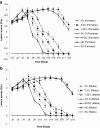In vitro and in vivo antidermatophytic activity of the dichloromethane-methanol (1:1 v/v) extract from the stem bark of Polyscias fulva Hiern (Araliaceae)
- PMID: 23641972
- PMCID: PMC3658906
- DOI: 10.1186/1472-6882-13-95
In vitro and in vivo antidermatophytic activity of the dichloromethane-methanol (1:1 v/v) extract from the stem bark of Polyscias fulva Hiern (Araliaceae)
Abstract
Background: During the last decades, the number of people suffering from dermatophytoses has seriously increased, mainly due to the development of resistant strains of microorganisms to a range of formally efficient antibiotics. Polyscias fulva, a medium size tree which grows in the West Region of Cameroon is traditionally used for local application against dermatoses and orally against venereal infections. The dichloromethane-methanol (1:1 v/v) extract from the stem bark of Polyscias fulva was evaluated for its in vitro and in vivo antifungal activities.
Methods: The plant extract was prepared by maceration of its stem bark powder in CH(2)Cl(2)-MeOH (1:1 v/v). The extract obtained was successively partitioned in hexane, ethyl acetate and n-butanol. Phytochemical screening was performed using standard methods. In vitro antidermatophytic activity was assayed by the well diffusion and broth microdilution methods. The degree of dermal irritation of the crude extract was determined in guinea pigs using the occluded dermal irritation test method. The in vivo antidermatophytic activity of the extract-oil formulation (1.25, 2.5 and 5% w/w concentrations) was evaluated using Trichophyton mentagrophytes-induced dermatophytosis in a guinea pigs model.
Results: Phytochemical screening indicated that, the crude extract, ethyl acetate, n-butanol and residue fractions contain in general saponins, tannins, alkaloids, anthraquinones and phenols while the hexane fraction contains only alkaloids. The ethyl-acetate, n-butanol and residue fractions displayed higher antifungal activities (MIC = 0.125-0.5 mg.mL(-1)) against eight dermatophytes as compared to the crude extract (MIC = 0.5-1 mg.mL(-1)). This latter appeared to have slight perceptible erythema effects on guinea pigs as the primary irritation index (PII) was calculated to be 0.54. In vivo, the antidermatophytic activities of the extract-oil formulations were dose-dependent. Griseofulvin-oil 5% at 0.01 g/kg and formulated extract-oil (5%) at 0.1 g/kg eradicated the microbial infection after thirteen and fourteen days of daily treatment respectively.
Conclusions: The results of preclinical in vitro and in vivo evaluations indicate that the extract-oil formulation at 5% may constitute an alternative means to alleviate fungal infections caused by dermatophytes.
Figures





Similar articles
-
Antibacterial and antioxidant properties of crude extract, fractions and compounds from the stem bark of Polyscias fulva Hiern (Araliaceae).BMC Complement Altern Med. 2017 Feb 7;17(1):99. doi: 10.1186/s12906-017-1572-z. BMC Complement Altern Med. 2017. PMID: 28173794 Free PMC article.
-
Antifungal properties of a new terpernoid saponin and other compounds from the stem bark of Polyscias fulva Hiern (Araliaceae).BMC Complement Altern Med. 2015 Feb 15;15:25. doi: 10.1186/s12906-015-0541-7. BMC Complement Altern Med. 2015. PMID: 25880310 Free PMC article.
-
In vitro and in vivo antidermatophytic activities of some Iranian medicinal plants.Med Mycol. 2015 Nov;53(8):852-9. doi: 10.1093/mmy/myv032. Epub 2015 Jun 19. Med Mycol. 2015. PMID: 26092105
-
Natural Products: An Alternative to Conventional Therapy for Dermatophytosis?Mycopathologia. 2017 Feb;182(1-2):143-167. doi: 10.1007/s11046-016-0081-9. Epub 2016 Oct 22. Mycopathologia. 2017. PMID: 27771883 Review.
-
Final report on the safety assessment of capsicum annuum extract, capsicum annuum fruit extract, capsicum annuum resin, capsicum annuum fruit powder, capsicum frutescens fruit, capsicum frutescens fruit extract, capsicum frutescens resin, and capsaicin.Int J Toxicol. 2007;26 Suppl 1:3-106. doi: 10.1080/10915810601163939. Int J Toxicol. 2007. PMID: 17365137 Review.
Cited by
-
Antioxidant and anti-inflammatory activities of extracts from Cassia alata, Eleusine indica, Eremomastax speciosa, Carica papaya and Polyscias fulva medicinal plants collected in Cameroon.PLoS One. 2014 Aug 4;9(8):e103999. doi: 10.1371/journal.pone.0103999. eCollection 2014. PLoS One. 2014. PMID: 25090613 Free PMC article.
-
In vitro and In vivo study targeting the development of Unani Antidermatophytic Cream: Implication of Herbal Formulations in Treatment of Dermatophytosis.Heliyon. 2023 May 9;9(5):e16154. doi: 10.1016/j.heliyon.2023.e16154. eCollection 2023 May. Heliyon. 2023. PMID: 37234648 Free PMC article.
-
In vitro antidermatophytic activity of bioactive compounds from selected medicinal plants.J Anal Sci Technol. 2021;12(1):53. doi: 10.1186/s40543-021-00304-3. Epub 2021 Nov 3. J Anal Sci Technol. 2021. PMID: 34745684 Free PMC article.
-
Antibacterial and antioxidant properties of crude extract, fractions and compounds from the stem bark of Polyscias fulva Hiern (Araliaceae).BMC Complement Altern Med. 2017 Feb 7;17(1):99. doi: 10.1186/s12906-017-1572-z. BMC Complement Altern Med. 2017. PMID: 28173794 Free PMC article.
-
Anti-trichophyton activity of protocatechuates and their synergism with fluconazole.Evid Based Complement Alternat Med. 2014;2014:957860. doi: 10.1155/2014/957860. Epub 2014 Jun 18. Evid Based Complement Alternat Med. 2014. PMID: 25136374 Free PMC article.
References
-
- Ananth BD, Maheswara U, Reddy C. Antimicrobial activity of Methanol Extract of Oxystelma esculentum. J Pharm Sci Technol. 2010;2:119–123.
-
- Lorougnon F, Heron P, Therizol M, Kanga J, Djeha D, Yoboue P, Boussou D. Efficacité clinique de la naftifine dans le traitement des dermatomycoses. Médecine d’Afrique noire. 1991;38:707–714. - PubMed
MeSH terms
Substances
LinkOut - more resources
Full Text Sources
Other Literature Sources
Medical

